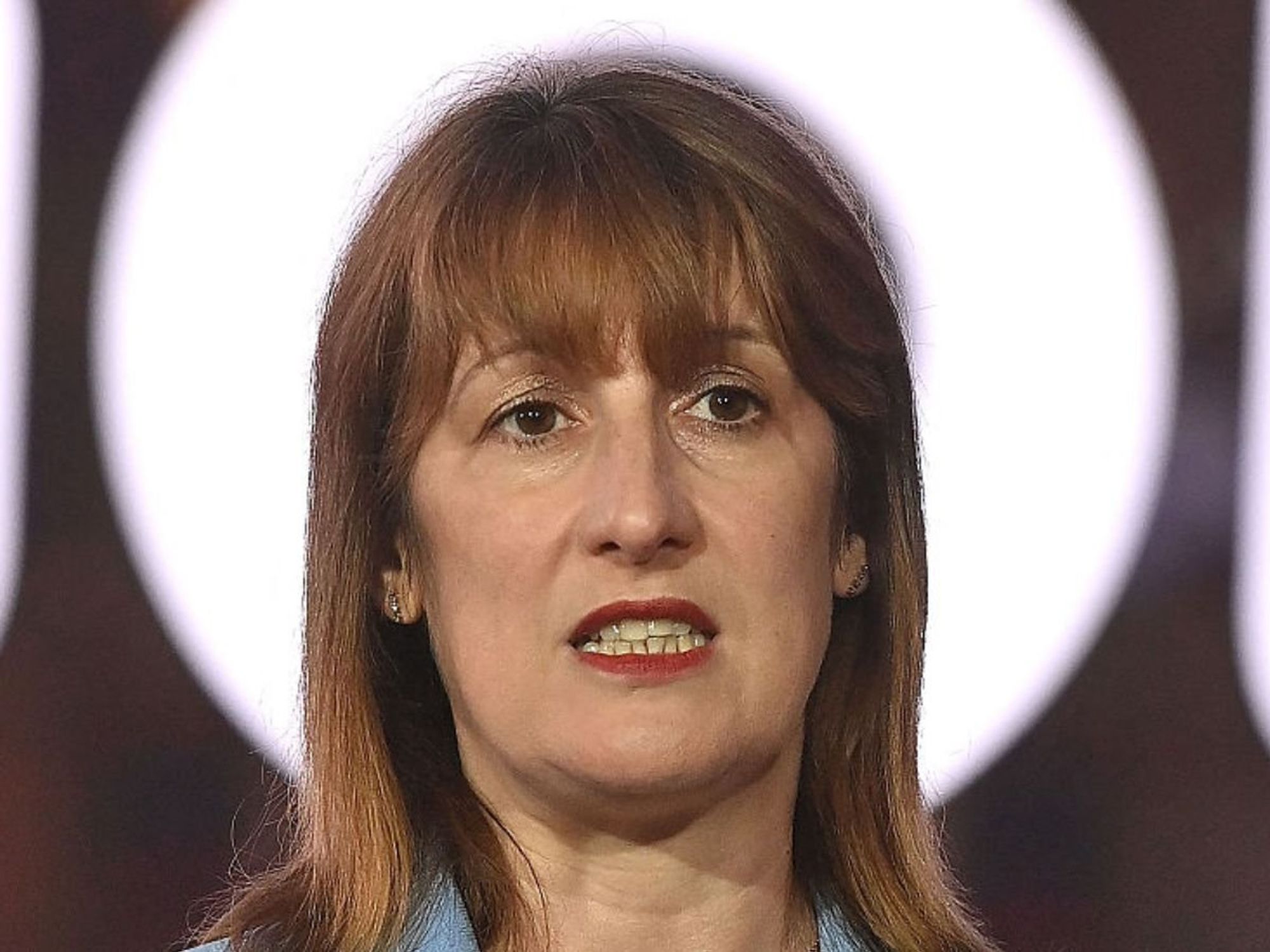How Apple Watch helps millions keep track of their heart health, and UK researchers look for new treatments

"We are working towards that more personalised approach," Asha Chesnutt M.D. tells GB News
Don't Miss
Most Read
With millions of devices packed with advanced health sensors in use worldwide every day, how do the teams inside Apple decide which feature to focus their time and resources on next? That's the question we put to Asha Chesnutt, M.D., who works as a Clinical Specialist inside Apple, developing the next generation of health features.
"The simple answer to that is we follow the science," Dr Chesnutt tells GB News.
"We have people doing research on very early-stage ideas throughout the company — we call them 'incubational' — trying to understand how our sensors can pick up different body signals. But we're also trying to make an impact, because we operate at such scale, we really want something that's helpful to all of our users."
Dr Chesnutt points to the most recent health-focused features rolled out by the Californian company — the abiltly to use the AirPods Pro 2 wireless earbuds, first launched two years earlier, as clinical-grade hearing aids, and sleep apnea detection on Apple Watch Series 9, Series 10, and Apple Watch Ultra 2 — which both rolled out to millions of device owners via a free software update.
- Apple VP talks transforming AirPods into Hearing Aids and UK becoming 'health superpower' on GB News
Hearing disorders and sleep apnea are both estimated to affect one billion people worldwide, Dr Chesnutt explains. As such, teams within the $3 trillion company want to have an impact on the largest number of people.
With the British Heart Foundation (BHF) warning that the 2020s has been the worst start to a decade for heart health in 50 years, helping wearers keep tab on their heart-beat and spot warning signs for conditions like atrial fibrillation, is another key focus.
But this mind-boggling scale — Apple Watch has outsold the entire Swiss watch industry, according to estimates — brings problems too. How does the US firm ensure that the metrics and advice delivered to wearers' wrists are tailored to them? After all, what warrants a low heart-rate warning for one user might be completely normal for someone else.
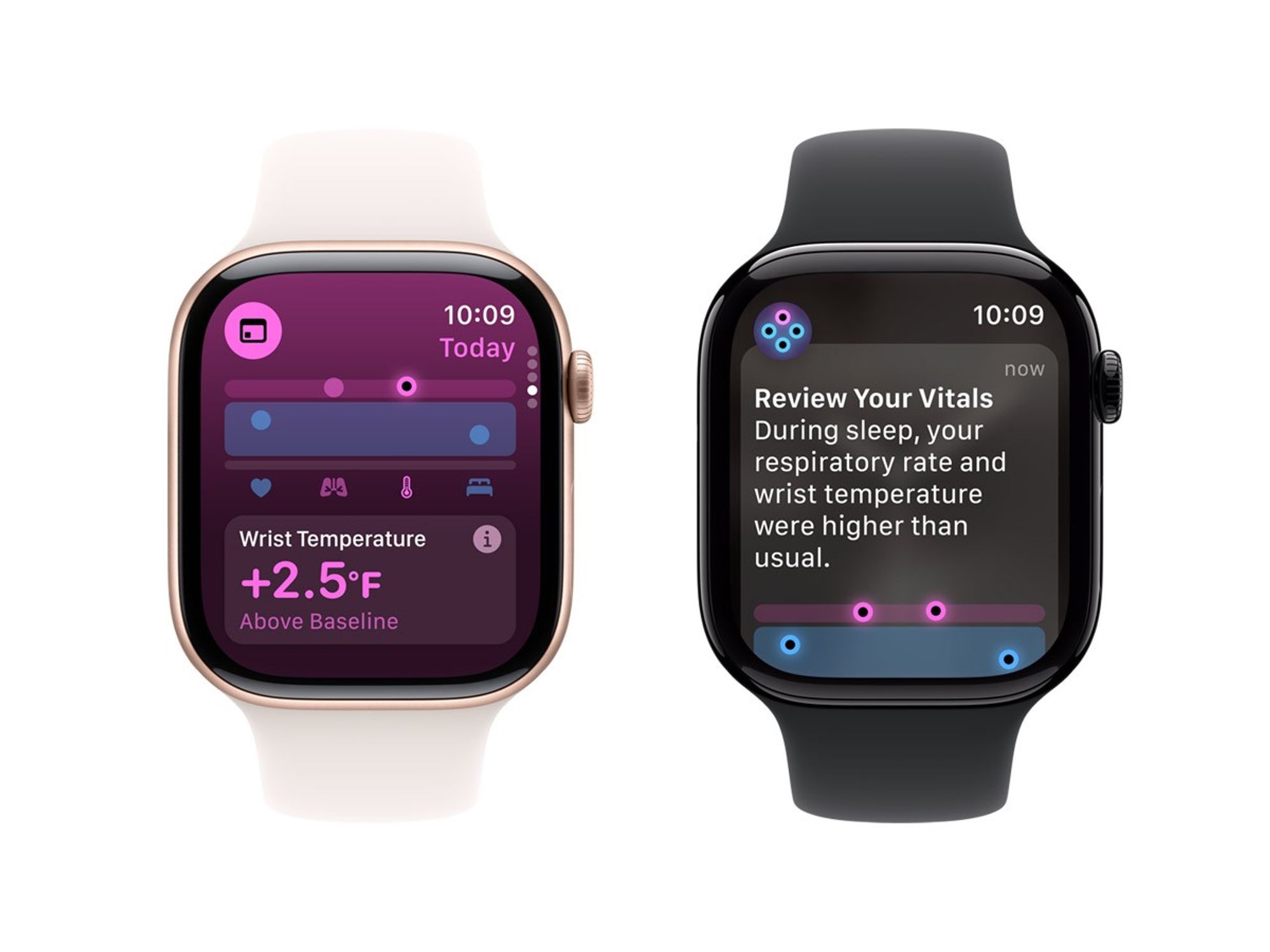
Vitals, a new app designed by the teams inside Apple and released last autumn, tracks your baseline readings across heart rate and respiratory rate, wrist temperature, and more. If something is outside of the usual range for you, then it will raise the alarm. This feature is not available immediately, since it takes time for the algorithm to learn what's typical for you
|APPLE PRESS OFFICE
Dr Chesnutt tells us: "We are working towards that more personalised approach. You can see that best in the Vitals app released last year, which is personalised to you."
This standalone app works as a "you-to-you comparison," Dr Chesnutt explains.
"The algorithm takes time to understand your own personal baseline of your heart rate, respiratory rate, sleep duration, spO2, and wrist temperature. And then when it detects a statistical outlier, it's able to tell you when something is outside of your typical range."
If something is awry, the Vitals app on Apple Watch will send a notification with a tailored message providing better context on your health. The company is keen not to cause alarm unnecessarily.
@gbnews Dr. Nikhil Ahluwalia discusses the Apple Watch's groundbreaking health potential #tech #health #applewatch
The Health app, preinstalled on every iPhone sold worldwide, includes educational articles with details on typical ranges for certain age groups and advice on how to improve health metrics if you're concerned.
Keeping a record of your health can be important if you need to see a GP or specialist about something that's been flagged by the Vitals app.
Dr Chesnutt explains: "It's really helpful as a physician to understand what someone's baseline is, so when they come to you and say 'my heart-rate in 105,' the first question most physicians will typically ask is 'what do you typical run?'.
"Vitals helps you understand that."
It's this continuous monitoring of health markers that first caught the attention of Dr. Nikhil Ahluwalia, who works as a Cardiology Registrar at Barts Heart Centre, London. Dr. Ahluwalia, who previously studied the impact of new diagnostic tools and drugs at Kings College London, approached Apple to help with a research project looking into ways to improve care for people with atrial fibrillation or who have suffered a stroke.
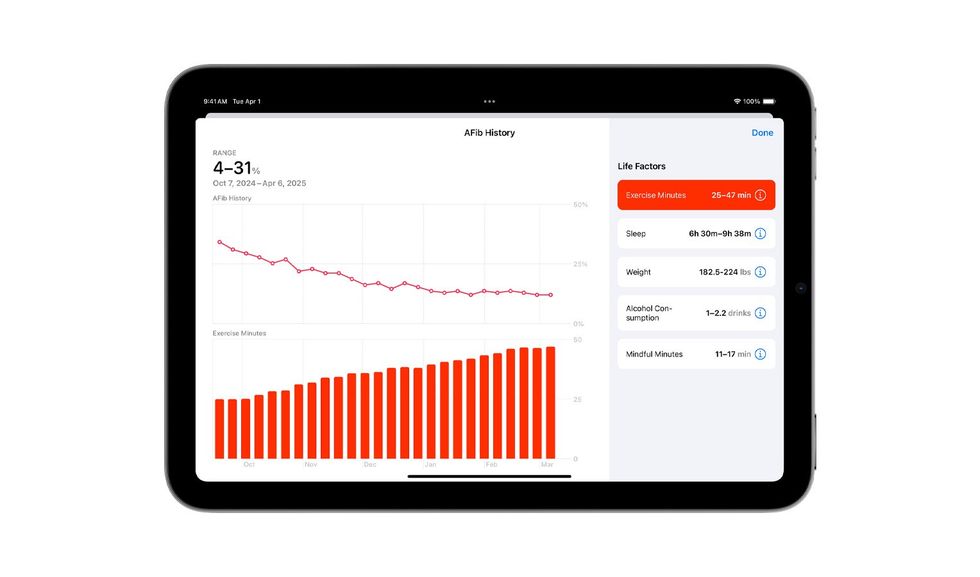
If you’ve been diagnosed with atrial fibrillation, AFib History on Apple Watch can estimate how frequently your heart is in AFib. You can also view how lifestyle factors like exercise and sleep may influence the condition
|APPLE PRESS OFFICE
"The amount of data we're collecting with these devices surprised me," Dr. Ahluwalia told us. "We went into [this research project] looking at just heart-rate and heart rythmn, but actually, what we've found is the data we're able to collect is much broader than that — how active people are on a daily basis, how far they're walking, their heart rate variability — which serves a measure of their fight or flight system."
"If you bring all of that data together, you're able to provide the patient sat in front of you with insights that you aren't able to do with previous technology, such as what their risk of developing heart rythmn issues is the following day, or the following week. I think it's an exciting time because of the mixing of different Artificial Intelligence models, and this large amount of data that we're able to provide new insights we haven't been able to provide before."
Dr. Nikhil Ahluwalia hopes to publish the findings on this research in the coming months, which could directly inform how patients are treated in the NHS. Apple, which provided its expertise and devices for patients in the study, will likely be watching to see whether the findings could have an impact on its plans for the next major update.
New analysis by the British Heart Foundation reveals there has been a rise in the rate and number of deaths in working-age adults aged 20-64 from cardiovascular disease in the UK. The rate rose to 55 deaths per 100,000 in 2023 from 49 per 100,000 in 2019 – that's the first sustained increase in at least a generation. Deaths in working age adults rose by 18 per cent, from 18,693 in 2019, to 21,975 in 2023, averaging 420 a week.
If you own an iPhone, Apple Watch, or AirPods and aren't sure you're using these devices to their full potential to monitor key aspects of your wellbeing, we've rounded up some of the latest health features available now.
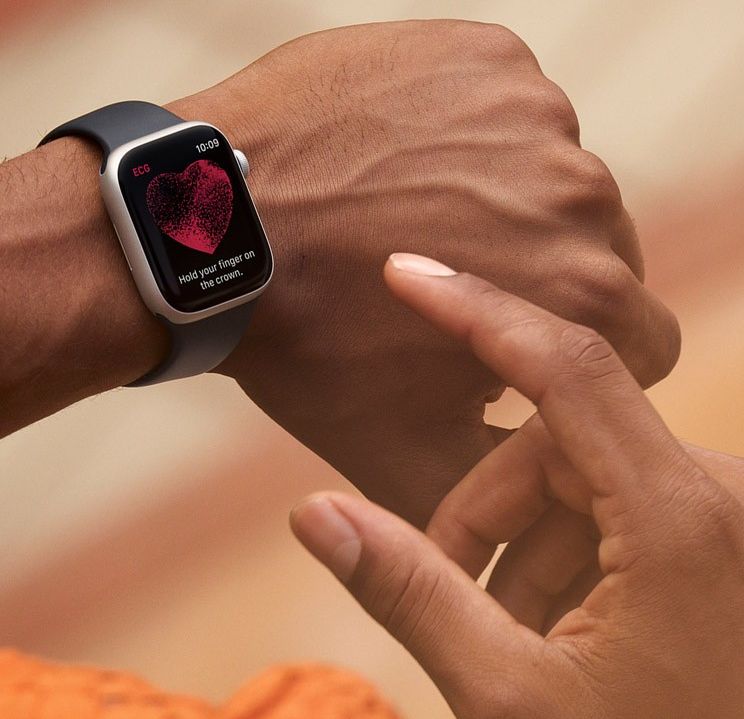
Some Apple Watch models can perform an ECG (electrocardiogram) that uses built-in electrodes to read and record the electrical heart signals straight from your fingertip and wrist. You can share a PDF of your ECG reading with your doctor
|APPLE PRESS OFFICE
Apple Watch can detect irregular heartbeats that might indicate atrial fibrillation. If left unmanaged, this condition can lead to several complications, including an increased risk of stroke, heart failure, and blood clots. Some studies have linked atrial fibrillation, sometimes referred to as AF or AFib, to an increased risk of dementia.
Wearing an Apple Watch throughout the day and night, the device can send a notification when it detects a concerning high or low heart-rate. Some models also have a built-in ECG (electrocardiogram) test that records the electrical activity of your heart. The results can be exported via PDF and sent directly to your GP.
Your cardio fitness level, measured via a metric called VO2 Max, is tracked during activities like outdoor walks, runs, or hikes, and serves as a strong indicator of overall physical health. The smartwatch calculates this by monitoring how hard your heart beats during exercise. If your cardio fitness level falls below normal for your age and gender, Apple Watch will prompt you to take action.
Even when you're not deliberately tracking a hike or outdoor run, Apple Watch tracks walking metrics in the background, including speed, step length, walking asymmetry, and six-minute walk distance. These measurements indicate injury, disability and long-term health prospects.
Fall Detection on Apple Watch provides crucial safety features, particularly for elderly users. When detecting a hard fall, it sounds an alarm and displays an alert — allowing you to immediately contact the emergency services with a tap, or dismiss if you're unharmed. If no action is taken, Apple Watch will assume you're unconscious and call for help.
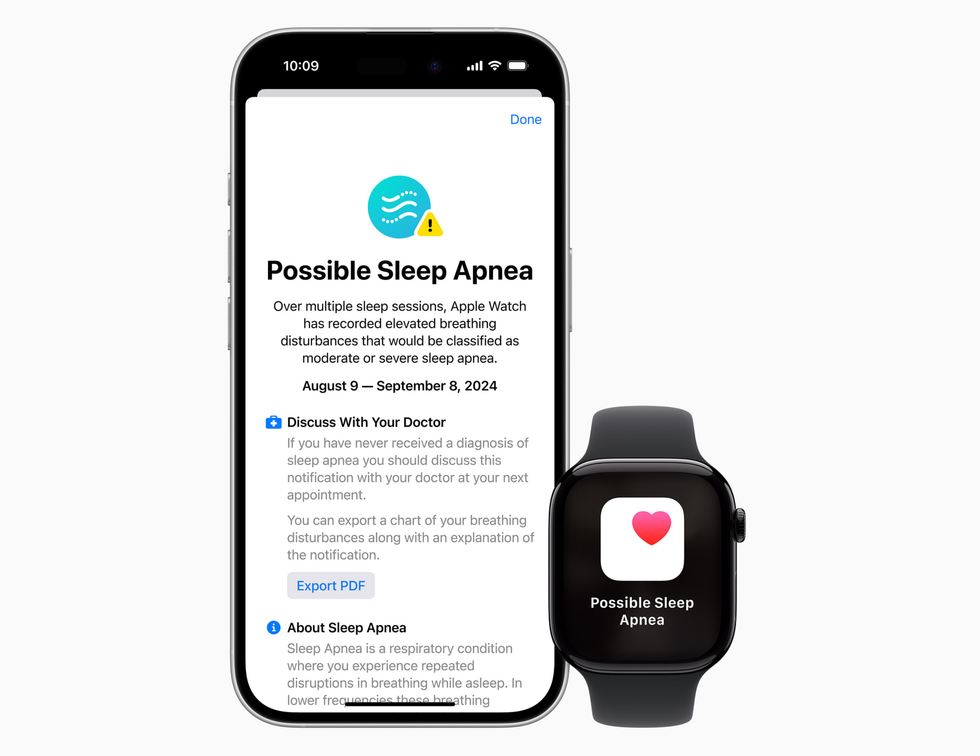
If you receive a notification, like the one above, you can export a PDF that shows when the sleep apnea may have occurred, put into context of three months of breathing disturbance data, and additional information for your GP
|APPLE PRESS OFFICE
At night, Apple Watch can track your sleep patterns and monitor breathing disturbances. These can be a signs of moderate to severe sleep apnoea. By monitoring disruptions in your breathing patterns, the Apple Watch will determine whether consistent patterns emerge and send a notification suggesting that you book a consultation with your doctor.
Sleep tracking also monitors the time spent in REM, Core and Deep sleep stages, providing insights into your sleep quality over 14 days. For women, the technology offers cycle tracking with ovulation estimates using skin temperature.
All of this data is used by the Vitals app to establish your typical ranges for overnight metrics including heart rate, respiratory rate, wrist temperature, blood oxygen and sleep duration.
When multiple metrics fall outside your normal range, you receive contextualised notifications explaining potential factors like medications, elevation changes or illness. This you-to-you comparison is designed to help Apple Watch owners understand thier daily health status and identify potential issues before they become serious concerns.
Apple’s Vice President of Health Dr Sumbul Desai about a new feature allowing AirPods to be used as hearing aids
All of this data is encrypted and accessible within the Health app on iPhone and iPad.
Launched in the UK earlier this year following a rule change by Downing Street, AirPods Pro 2 now offer a built-in hearing test that identifies hearing loss and displays your hearing ability across different sound frequencies measured in decibels hearing level (dBHL).
If the test reveals mild to moderate hearing loss, the Hearing Aid feature customises your AirPods' sound output to match your specific hearing needs. This feature is designed for users aged 18 and older.
This is designed to transform your everyday earbuds into medical-grade hearing assistance devices.









